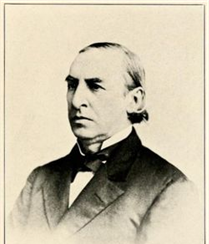George Duffield Jr., came from a family of preachers. Jr. is a bit of a misnomer – he was the fifth such George Duffield. The first Duffield was a native of Belfast, the second was chaplain to the Continental Congress. The fourth was a Presbyterian minister, as was our subject, Duffield the Fifth. Interestingly he did not pass on his name to any of his sons.
His family was quite educated – the family tombstones nearby are inscribed in three languages, and he himself graduated from Yale.
A church music conference was going on in Detroit so my wife and I went to it. Afterwards they accompanied me on my search for the grave of Mr. Duffield. Unfortunately, the cemetery given was incorrect – so we had to go across town to find the actual cemetery, Elmwood. Near to downtown, it is the oldest non-denominational cemetery in Michigan.
Duffield’s fame interestingly comes from a song that he wasn’t even the inspiration for. His friend Dudley Tyng was kicked out of his Episcopalian church because of his strong abolitionist stance.
On March 30, 1858, with the Philadelphia YMCA, Tyng hosted a rally that over 5,000 people attended. He preached on the text, Ye that are men, and serve the Lord and declared to the assembled fathers and sons, “I would rather this right arm be amputated at the trunk than that I should come short of my duty to you in delivering God’s message.”
A fortnite later, Tyng’s sleeve was caught in the machinery at a farm and it grabbed his arm. The arm had to be amputated, but it was too late. His last words were “Tell my brethren wherever you meet them, to stand up for Jesus!”
Duffield wrote the song that is inscribed on his tombstone:
Stand up, stand up for Jesus,
Ye soldiers of the cross;
Lift high his royal banner,
It must not suffer loss.
From victory unto victory
His army shall he lead,
Till every foe is vanquished,
And Christ is Lord indeed
Hymn History: Stand Up, Stand Up for Jesus & Author: George Duffield, Jr.
“I caught its inspiration from the dying words of that noble young clergyman, Rev. Dudley Atkins Tyng… His last words were, ‘Tell them to stand up for Jesus: now let us sing a hymn.’ As he had been much persecuted in those pro-slavery days for his persistent course in pleading the cause of the oppressed, it was thought that these words had a peculiar significance in his mind; as if he had said, ‘Stand up for Jesus in the person of the downtrodden slave.'”
(George Duffield, Jr.)
The Origin of the Hymn “Stand Up, Stand Up for Jesus”
Few hymns in the history of evangelical Christianity capture the call to courage and steadfastness as powerfully as “Stand Up, Stand Up for Jesus.” Its stirring words and commanding melody have inspired generations of believers to boldness in faith, courage in witness, and dedication to Christ. The hymn’s origin reflects a combination of personal tribute, wartime experience, and revivalist zeal, illustrating how life events and spiritual conviction can merge into enduring hymnody.
George Duffield Jr.: The Lyricist
The words of the hymn were written in 1858 by George Duffield Jr. (1818–1888), a Presbyterian minister from Pennsylvania. Born into a family with deep clerical roots—his father, George Duffield Sr., was also a prominent pastor—Duffield Jr. exhibited a strong dedication to ministry from an early age. He served as pastor of several congregations in Pennsylvania and Michigan and was known for his fervent preaching and pastoral care.
The inspiration for “Stand Up, Stand Up for Jesus” came from a personal tragedy: the death of his friend and fellow minister, Rev. Dudley Atkins Tyng. Tyng, a young pastor from Philadelphia, had become a passionate advocate for abolition and social reform. He died in 1858 after an accident while riding a horse. Before his death, Tyng had famously exhorted his congregation: “Stand up for Jesus!” Duffield, moved by his friend’s faithfulness and zeal, wrote the hymn in Tyng’s memory as a tribute and as a call to others to emulate his courage.
Composition of the Hymn
Duffield’s text is rich with imagery drawn from Scripture, particularly passages that emphasize spiritual warfare and perseverance in faith. The opening lines, “Stand up, stand up for Jesus, ye soldiers of the cross,” immediately set a martial tone, likening the Christian life to a battle that requires courage, discipline, and unwavering commitment. Later verses remind believers of Christ’s sacrifice and promise of eternal reward, connecting earthly perseverance with heavenly victory.
The hymn’s appeal lies in its balance of exhortation and encouragement. While it calls for strength and action, it also reassures Christians that their efforts are supported by Christ and will ultimately be vindicated. This dual emphasis reflects Duffield’s own pastoral philosophy: faith is both active and dependent on divine grace.
George James Webb: The Composer
The most commonly used tune for “Stand Up, Stand Up for Jesus” is “Webb,” composed by George James Webb (1803–1887), an English-born musician who immigrated to the United States. Webb was a skilled composer of hymn tunes and became known for his work in church music in New York and New England.
The tune “Webb” features a strong, march-like rhythm that complements the martial imagery of Duffield’s text. Its simple yet bold melody allows congregations to sing with confidence and conviction, making it ideal for revival meetings, Sunday services, and other gatherings. The combination of text and tune produces a hymn that is both uplifting and galvanizing, capable of inspiring both personal devotion and corporate unity.
Publication and Early Use
The hymn was first published in 1858 in The Church Psalmist and quickly spread throughout Presbyterian and other Protestant churches in America. Its call to courage resonated not only in spiritual contexts but also in social ones. The years leading up to the Civil War were fraught with tension over slavery and national identity, and the hymn’s imagery of standing firm in the face of opposition spoke powerfully to congregations confronting moral and social challenges.
Revival meetings of the late nineteenth century further popularized the hymn, as it was often used to encourage converts to commit fully to Christ. Its martial imagery and simple refrain made it particularly effective in rallying believers to action, whether in personal evangelism, mission work, or maintaining fidelity to Christian principles in daily life.
Themes and Legacy
At its core, “Stand Up, Stand Up for Jesus” emphasizes steadfastness, courage, and obedience. It encourages believers to take an active role in their faith, reminding them that the Christian life requires vigilance and perseverance. Its imagery of soldiers of the cross resonates with Scripture, particularly passages such as Ephesians 6:10–18, which speak of the armor of God and spiritual warfare.
The hymn’s legacy has endured for more than 160 years. It remains a staple in hymnals across denominations and continues to be sung in churches, revival meetings, and special ceremonies. Its message of courage and commitment transcends its original historical context, offering inspiration to new generations of believers who face challenges in both faith and life.
Conclusion
The origin of “Stand Up, Stand Up for Jesus” is rooted in both personal tribute and a broader call to faithful living. George Duffield Jr.’s words, inspired by the life and exhortations of Rev. Dudley Atkins Tyng, were given musical life by George James Webb, producing a hymn that combines spiritual inspiration with musical strength. Over the decades, it has become more than a memorial; it is a timeless exhortation to courage, dedication, and perseverance in Christ. Today, congregations around the world continue to sing this hymn, standing firm in faith and echoing the clarion call first penned in the mid-nineteenth century: Stand up for Jesus!
_____
Featured Image Credit: Public domain
Related
Sorry, no records were found. Please adjust your search criteria and try again.
Sorry, unable to load the Maps API.

